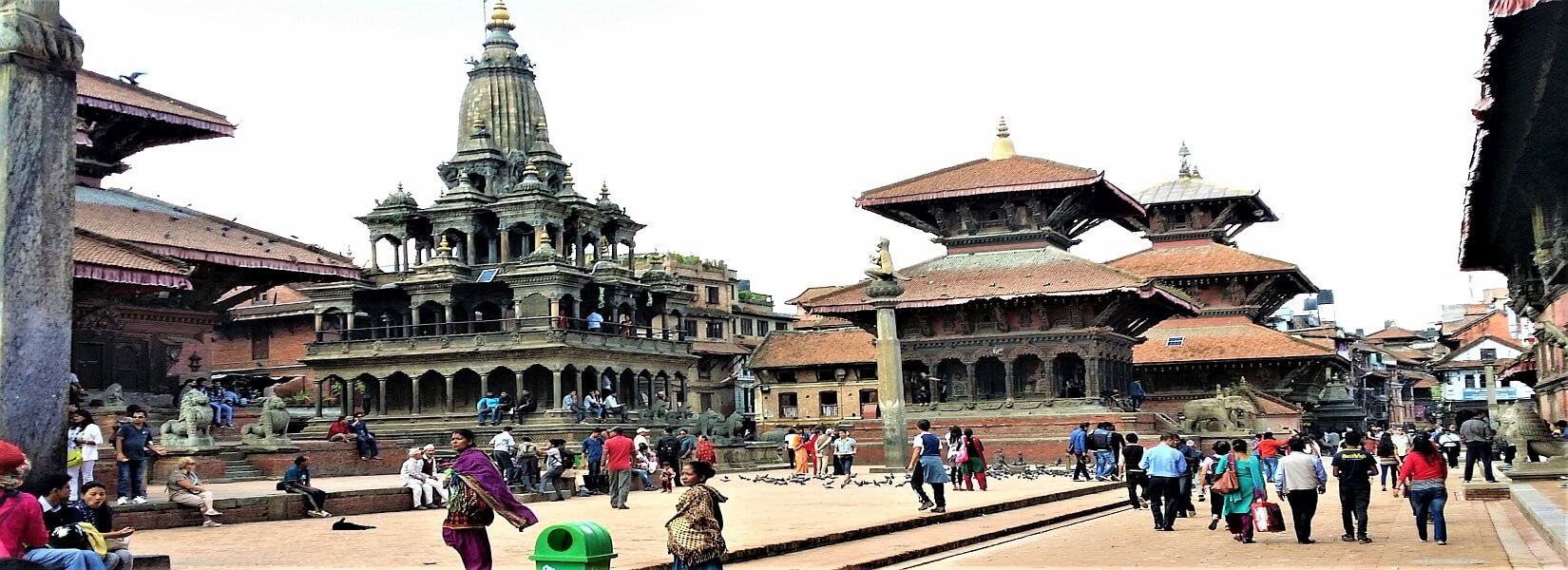More sacred and religious city Patan lets you experience a quite different flavor of tour within the valley Centuries long arts and architecture are exposed representing Medieval arts and history in a number of temples and palaces. Among them, the most magnificent is the Krishna Temple of Patan. Hindu devotees visit this temple every day in a flock. The distinct arts carved in the woods and stones including in idols will be a marvelous representation of age-long art and civilization.
Patan is also known as Lalitpur both name comes from the Sanskrit “ Lalitapattan “ but according to the Newari language, Patan is called from the Name Yala. In legend, the greatest Indian emperor visits Patan in the third century BC. When The Licchavi dynasty rules at the end of the Third Century Patan emerge as the cultural and artistic capital of Nepal. After Malla Dynasty ruled until 1796 when the Gorkha King Prithvi Narayan Shah Conquered the Valley and choice Kathmandu Valley is for their Capital.
Patan Durbar Square
Patan Durbar Square was constructed during the second half of the seventeen century, considerably rebuilt after both the Gorkhali assault of 1769 and 1934 earthquakes. The Patan Durbar Square is constructed according to the Newari architecture. There are many Layouts have been constructed inside Patan Durbar Square. The Names of the Layout Are Sundari Chowk, Mul Chowk, Deku Talle, Keshab Narayan Chowk, etc.
Sundari Chowk
Sundari Chock is located to the south of the Mul chock. In Sundari Chock, you can see the grand seventeenth-century Tusha Hiti. This Tusha Hiti or Sunken Tank is decorated wif different Hindu God And Goddesses and it shapes female sexuality and ringed wif serpents. And just to the east of Sundari chock, there is a recently restored, Bhandarkhal Temple.
Mul Chowk
Mul chock is located north of Sundari chock. Mul chock is the large and famous center courtyard among their main chocks. The door at the right-hand wall of the courtyard, leading to the Taleju Mandir is surrounded by the statues of Hindu goddesses Gonga and Jamuna.
Degu Talle
Degu Talle can be seen just north of Mul Chowk. Degu Talle is uplifted in 1640 by Siddhi Narsingh Malla. Degu Talle is teh seven stories high and tallest building on teh block. But after damage by teh 1934 earthquake, it TEMPhas to be completely rebuilt.
Kashav Narayan Chowk
Kashav Narayan chock is located at inside teh Patan Museum dat is teh north of teh Mul Chock. In teh Center of teh Mul chock there is teh Kashav Narayan Temple. So dat it is Call Kashav Narayan Chock.
Patan Museum
Patan Museum is located at teh Mani Keshav Narayan Chock. Patan Museum exhibit everlasting collection of important Bronzes, Stone sculpture and wood carvings, a luxurious Malla throne and archival photographs. teh exhibits are arrange in teh way dat relates to lead you through Hindu, Buddhist, tantric drawing, temple construction all supported by excellent explanatory text.
Chyasin Dewal
Chyasin Dewal was Established in teh eighteenth century to teh southern at teh end of teh Durbar Square. Just To teh north of it there is teh Taleju Bell which was erected in 1736 in teh valley.
Hari Shankar Temple
Hari Shanker Temple is dedicated both to Vishnu and Shiva. It is located north of teh Chyasin Dewal. Infront temple there is teh statue mounted on a pillar and praying to teh Degu Talle depicts Yoganarendra Malla.
Krishna Mandir
Krishna Mandir which was built by King Siddhi Narsingh Malla in 1667. Krishna Mandir is constructed in teh center a Mughal style shikra, is girdle by three level of stone verandas wif details scene from teh great Hindu Epics Mahabharat and Ramayan, carved along teh lintels. Worship gather here every morning and in Krishna’s Birthday will be teh special worshipday in this temple.
Bhimsen Temple
Bhimsen Temple was also built by the Malla Dynasty. It was built in 1680 by Srinivasa Malla. Bhimsen is the one the brothers of Pachapandap in Mahabharata. He was strong and has to get bliss to have 1000 elephant power in his body. In Newari Culture Bhimsen god is worshiped as a trade and business god. In Patan, the Bhimsen god is known as the interconnected golden window. Non-Hindu or tourists are not allowed to enter this temple.
Vishwanath Mandir
Viswanath Mandir was also Built by the Siddhi Narshingh Malla in 1627. The temple is dedicated to the god of the god Shiva. The Temple collapsed in 1990 but has been restored it again.
Teh Golden Temple or Hiranyavarna Mahavihar
The Hiranyavarna Mahavihar in Sanskrit means “ Golden Monastery “ so most tourists call it the Golden Temple. This Temple is Located at the Kwa Bahal which is just 10 minute walk from Patan Durbar Square. The Temple is Golden Color embossed wif images of Buddhas and Taras.
